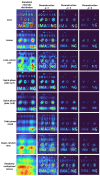Nonlinear Reconstruction of Images from Patterns Generated by Deterministic or Random Optical Masks-Concepts and Review of Research
- PMID: 35735973
- PMCID: PMC9225382
- DOI: 10.3390/jimaging8060174
Nonlinear Reconstruction of Images from Patterns Generated by Deterministic or Random Optical Masks-Concepts and Review of Research
Abstract
Indirect-imaging methods involve at least two steps, namely optical recording and computational reconstruction. The optical-recording process uses an optical modulator that transforms the light from the object into a typical intensity distribution. This distribution is numerically processed to reconstruct the object's image corresponding to different spatial and spectral dimensions. There have been numerous optical-modulation functions and reconstruction methods developed in the past few years for different applications. In most cases, a compatible pair of the optical-modulation function and reconstruction method gives optimal performance. A new reconstruction method, termed nonlinear reconstruction (NLR), was developed in 2017 to reconstruct the object image in the case of optical-scattering modulators. Over the years, it has been revealed that the NLR can reconstruct an object's image modulated by an axicons, bifocal lenses and even exotic spiral diffractive elements, which generate deterministic optical fields. Apparently, NLR seems to be a universal reconstruction method for indirect imaging. In this review, the performance of NLR isinvestigated for many deterministic and stochastic optical fields. Simulation and experimental results for different cases are presented and discussed.
Keywords: Fresnel incoherent correlation holography; coded aperture imaging; computational imaging; diffractive optics; holography; nonlinear reconstruction; rotating point spread function; scattering.
Conflict of interest statement
Christian Depeursinge has financial interests in Lyncee Tec and Nanolive; Pierre J Magistretti has financial interests in Lyncee Tec.
Figures
















References
-
- Bryngdahl O. Geometrical transformations in optics. J. Opt. Soc. Am. 1974;64:1092–1099. doi: 10.1364/JOSA.64.001092. - DOI
-
- Rosen J., Vijayakumar A., Kumar M., Rai M.R., Kelner R., Kashter Y., Bulbul A., Mukherjee S. Recent advances in self-interference incoherent digital holography. Adv. Opt. Photon. 2019;11:1–66. doi: 10.1364/AOP.11.000001. - DOI
-
- Liu J.P., Tahara T., Hayasaki Y., Poon T.-C. Incoherent digital holography: A review. Appl. Sci. 2018;8:143. doi: 10.3390/app8010143. - DOI
-
- Poon T.-C. Optical scanning holography-a review of recent progress. J. Opt. Soc. Korea. 2009;13:406–415. doi: 10.3807/JOSK.2009.13.4.406. - DOI
Publication types
Grants and funding
LinkOut - more resources
Full Text Sources
Miscellaneous

